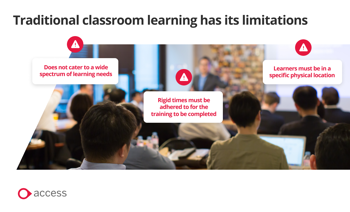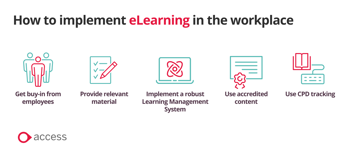What is eLearning?
eLearning offers a flexible and efficient way for learners to upskill and develop, far removed from the constraints of the traditional classroom. It’s a transformative tool that allows learning to be rolled out by an organisation at the most suitable time. Successful eLearning implementation is more than just technology; it's a strategic endeavour.
In this article we will look at why eLearning should be implemented, what eLearning content is available, and the best way to introduce eLearning into your L&D strategy.
In this article we'll discuss:
The importance of eLearning in the workplace
With hybrid and remote working turning into a mainstay for the modern workforce, it’s no surprise that learning styles have had to adapt.
CIPD recently reported that eighty-three per cent of organisations have hybrid working in place.
This shift in work dynamics meant an evaluation of how employees acquire new skills and knowledge was needed. This is where eLearning in the workplace comes into play.
Traditional classroom learning has its limitations such as:
- It does not cater to a wide spectrum of learning needs
- Rigid times must be adhered to for the training to be completed
- Learners must be in a specific physical location
Alternatively, eLearning offers an adaptable approach to employee learning and development. It should be considered at an organisational level as it provides accessible, flexible, and efficient learning opportunities that empower employees to thrive in the evolving world of work.
Traditional classroom learning has its limitations

eLearning meaning explored
eLearning enables learners to access training content at their convenience using devices like laptops, PCs, mobile apps, and tablets, provided they have an internet connection. It empowers organisations to deliver timely and relevant training and development content to their intended audience
When considering how to implement eLearning in the workplace, it is important to think about how employees prefer to learn. Not everybody absorbs information in the same way, so accommodating different learning needs, such as Gen Z styles of learning, should be taken into account.
Is there is a difference between eLearning and digital learning?
While digital learning and eLearning share similarities in their use of technology, it's important to understand a crucial difference. Digital learning is a broad term encompassing various forms of education facilitated by technology.
In contrast, eLearning is a specific subset of digital learning, characterised by a fully online educational experience conducted exclusively through the internet.
eLearning can include different formats such as text-based materials, videos, interactive simulations, assignments and gamified learning elements like quizzes. In essence, eLearning can be seen as an important component of the broader digital learning landscape.
Often delivered through an eLearning system, such as a Learning Management System (LMS), eLearning provides learners with a structured and guided learning experience.
Microlearning is a great example of an eLearning format - it uses bitesize modules and digestible learning content to make learning easy to take in. For employees who may not have a lot of time to dedicate to their learning, microlearning offers a convenient and effective solution. Short, focused lessons can be completed quickly, allowing employees to fit learning into their busy schedules.
What eLearning Content is available in the workplace?
eLearning is an extremely efficient method of delivering employee training. As well as including varying formats, there is a wide variety of learning topics that can be introduced to your employees depending on your organisation, their roles and their personal development needs.
Let’s explore some content that you may be interested in.
Learn more about the benefits of eLearning for employees and businesses.
How to implement eLearning in the Workplace

What is the best way to implement eLearning in the workplace?
When you are looking to introduce eLearning in the workplace, it's crucial to have a well-thought-out strategy that ensures its success. Here are some key points to consider for a successful eLearning implementation:
1. Buy-in from employees
If your organisation is in the early stages of its learning journey or if you're a smaller business not utilising an LMS, it's vital to secure buy-in and active engagement from employees looking to use the learning materials. Communicate the benefits and significance of eLearning to your workforce, and engage with employees across all levels to address their concerns. Demonstrating how eLearning can have a positive impact on their job performance and career development will result in a bigger uptake in users and a better experience all round.
2. Relevant material
Effective implementation of eLearning in the workplace hinges on delivering timely and relevant training. By aligning learning with employees' current needs, engagement with the learning materials is likely to increase. When training content is distributed when crucial updates or vital information needs to be shared, it guarantees that employees receive knowledge and skills directly applicable to their roles.
3. A robust Learning Management System
A user-friendly and interactive LMS is the backbone of a successful eLearning implementation process for organisations juggling a wide range of training requirements. A good LMS will keep all learning material in one place and provide your organisation with the ability to assign, track and report on the learning. For large organisations with a wide range of employees and job roles the LMS can efficiently cater to diverse learning needs and roll out learning at scale.
4. Accredited content
Content that is accredited by relevant bodies, such as Continuing Professional Development (CPD) accreditation, carries a stamp of approval that signifies its quality and relevance. This can instill trust in the training materials and reinforce their value, motivating employees to carry out regular training. The eLearning content you invest in should be endorsed by credible authorities and created in partnership with subject matter experts.
5. CPD tracking
Implementing eLearning tools that track and manage employee career development activities is crucial for their growth and career advancement. Providing CPD tracking tools allows individual employees to monitor and manage their progress. By facilitating CPD, you not only enhance the skills and knowledge of your workforce but also foster a culture of continuous learning and improvement.
How to improve eLearning in your organisation
Sourcing a breadth of eLearning courses that are relevant to the needs of your employees is a critical component, and it will vary for each organisation. However, offering high-quality and reliable content is key to the process no matter what sector your employees work in.
Utilising an eLearning system such as an LMS can help to motivate employees and lets them engage with a wide variety of content. Using the processes and methods that have been outlined, you can start to improve eLearning in the workplace and reap the rewards of a motivated workforce.
Find out how our accredited eLearning courses can engage learners with relevant content on a wide variety of topics.
What is eLearning FAQs
Does eLearning mean online?
Yes, eLearning primarily takes place online. It involves using electronic devices, such as tablets, phones, and computers, to access learning materials, and these resources are web-based. The internet is a fundamental component of eLearning as it allows learners to access, interact with, and benefit from the digital educational content.
Is eLearning better than offline learning?
eLearning and offline learning have their unique advantages and considerations. eLearning offers flexibility and convenience and is highly engaging when the content is relevant to the user’s needs. Offline learning encourages social interaction and feedback but can be costly and time-consuming. The choice depends on specific needs and preferences of your organisation.

